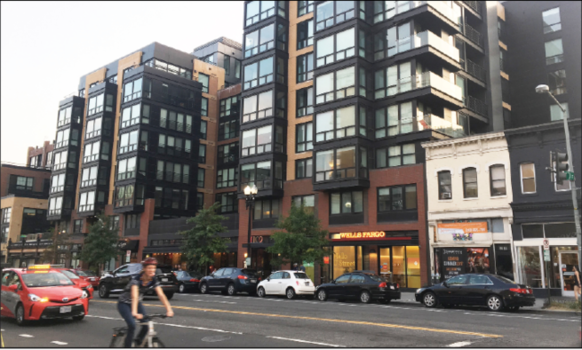
 |
|
New apartment buildings and businesses sprout up on 14th Street near U Street in Washington a photo taken on Sunday. The traditionally black neighborhood has seen an increase in the white population along with skyrocketing real estate prices. Chen Weihua / China Daily |
Having lived in Washington DC for almost five years, I have seen the city growing, with new construction and renovation projects happening in many streets and neighborhoods.
The Wharf residential and business project I visited recently is probably one of the biggest. Located in southwest Washington along the waterfront next to the famed Maine Avenue Fish Market, its first phase will open on Oct 12. The second phase is set for completion in 2021.
Only a short walk from the National Mall, it looks like a good place to live, work and hang out.
The same urban renewal is happening in other parts of Washington. The U Street/Shaw and 14th Street area has fast been turned into an upscale neighborhood in recent years, with many new restaurants and shops opening and new apartment construction.
These changes may look pleasant, but not quite so to Derek Hyra, an associate professor at the American University School of Public Affairs and an expert on neighborhood change.
He saw major issues of gentrification and segregation in Washington beneath the surface of rapid urban renewal. His book this year, Race, Class, and Politics in the Cappuccino City, is the result of his many years of field research on the issues.
Hyra described the massive transformation in the U Street/Shaw area, where the city's once most infamous open-air drug market has become a farmers' market now selling grass-fed beef and homemade duck egg ravioli.
The area, a 90 percent black neighborhood just a few decades ago, was only 30 percent African American by 2010. Whites are the majority now, accounting for 55 percent of the community.
Hyra described how the "dark ghetto" has been turned into a "gilded ghetto". To Hyra, it has caused not just residential displacement for African Americans but also political and cultural displacement.
In a meeting with a group of foreign journalists, Hyra talked about how African Americans in the neighborhood refused to walk their dogs in a new dog park. He said they resent the park because they had appealed for an upgrade to the area, but it wasn't turned into a dog park until whites moved in.
On the surface, the Shaw and 14th Street area looks increasingly like the most diversified area in Washington. But Hyra found micro-level segregation when people go to churches and bars.
If you pass by a school in Washington, it's not hard to tell that city schools are still very much segregated even though racial segregation is illegal in the United States.
A report this year by the UCLA Civil Rights Project shows that schools in DC remain intensely segregated.
According to the report, the overall share of African American and Latino students in Washington who attended such segregated public schools - those with 90 to 100 percent minority enrollment - decreased between 1992 and 2013, but remained very high.
Nearly 90 percent of black public school students went to "apartheid schools" - completely nonwhite or within 1 percent of total segregation - in 1992; the percentage was as high as 71 percent in 2013.
These are serious issues that people don't read much about in US mainstream media or watch in hearings on Capitol Hill, located a few blocks from those neighborhoods.
Contact the writer at chenweihua@chinadailyusa.com